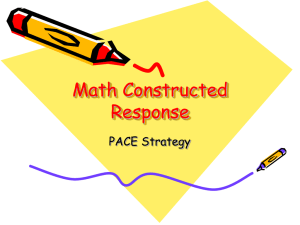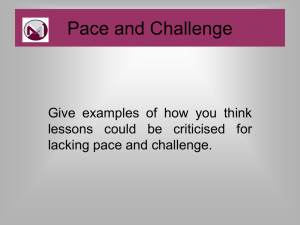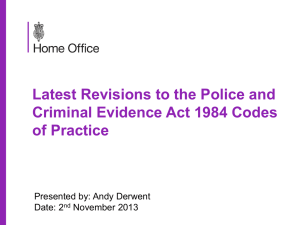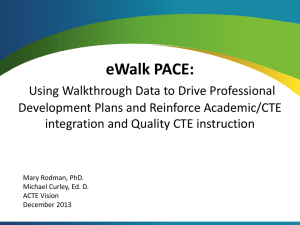The PACE Framework
advertisement
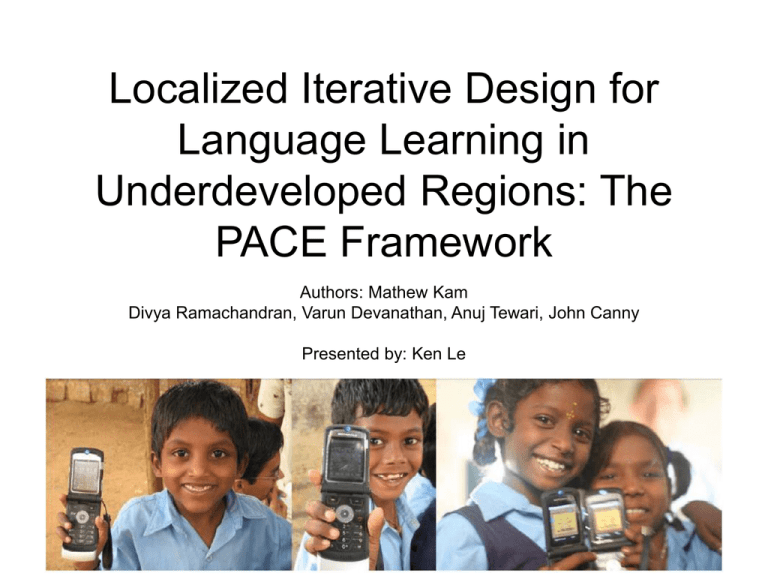
Localized Iterative Design for Language Learning in Underdeveloped Regions: The PACE Framework Authors: Mathew Kam Divya Ramachandran, Varun Devanathan, Anuj Tewari, John Canny Presented by: Ken Le Overview • Background • Main Topics – Design Challenges – Solution: The PACE Framework – Implementation and User Studies • Conclusion • Questions Background What is the PACE Framework? • A framework that supports flexible, rapid, and scalable development of language learning software localized for a particular community of learners. Background Project MILLEE • Mobile and Immersive Learning for Literacy in Emerging Economies http://www.cs.berkeley.edu/~mattkam/millee/ Background Why? • English considered as tool for success in emerging economies • Many schools in developing regions do poorly in second language education – 26% of children cannot read English alphabet after 1 year – 25% teacher absent rate – 43% children do not attend school regularly • Huge divide occurring http://www.citris-uc.org/files/MattKam%20TIER%20Workshop.pdf Background Video TV documentary on novel cell phone usage. “Cell Phone: The Ring Heard Around the World” http://www.cbc.ca/doczone/cellphones/video.html • Features parts of project MILLEE • Set stage for discussion on the PACE Framework The PACE Framework: Main Topics 1. Design Challenges 2. Solution: The PACE Framework 3. Implementation and User Studies 1) Design Challenges 1) Design Challenges Cultural Challenges • Understanding of user’s educational baseline • User’s with limited computing experience • Uncommon cultural backgrounds 1) Design Challenges Software Challenges • Flexibility • Fast Iterations • Scalability 2) Solution: The PACE Framework 2) Solution: The PACE Framework The PACE Framework • Layered architecture that allows for flexible, iterative, and scalable design • • • • Pattern Activity Curriculum Exercise Exercise Activity Pattern Curriculum 2) Solution: The PACE Framework Curriculum • • • • Alphabet Vocabulary Images Pronunciations Curriculum 2) Solution: The PACE Framework Example Curriculums Vocabulary curriculum Alphabet curriculum <curriculum> <wordlist> <word>apple</word> <word>banana</word> <word>orange</word> </wordlist> </curriculum> <curriculum> <alphabet> <letter>a</letter> <letter>b</letter> . . <letter>z</letter> </alphabet> </curriculum> Pure content, no presentation 2) Solution: The PACE Framework Pattern • A template • Interested in patterns current language learning software use to implement learning tasks Pattern Curriculum 2) Solution: The PACE Framework Pattern Example Receptive Phase • Banana • Apple • Orange 2) Solution: The PACE Framework Pattern Example Activation Phase • Banana ? • Apple ? • Orange ? 2) Solution: The PACE Framework Pattern • Many patterns available • Why patterns? Spend energy on other design tasks, not on reinventing the wheel 2) Solution: The PACE Framework Activity Activity Pattern Curriculum 2) Solution: The PACE Framework Exercises • Combination of patterns, activities, and curriculums Exercise Activity Pattern Curriculum 2) Solution: The PACE Framework Example: Three Exercises Alphabet Curriculum 2) Solution: The PACE Framework Example: Two Exercises apple Alphabet Curriculum orange banana Vocabulary Curriculum 2) Solution: The PACE Framework The PACE Framework • Layered architecture allows for – Flexibility • Adapt to a culture or age group based on choice of curriculum, pattern, and activity – Fast Iterations • Lots of reusable curriculums, patterns, and activities • Modifications only need to be done at certain layers – Scalability • • • • Content specialists can focus on curriculum Teaching specialists can focus on patterns Application developers can focus on user interface Many exercises that fit various cultures and age groups may be developed based: e.g. one curriculum to many activities 3) Implementation and Case Studies 3) Implementation and User Studies Implementation • 35 software applications reviewed • 50 patterns identified • 11 patterns chosen for initial language learning • 6 activities implemented • 21 curricula: – alphabet, numbers, dates, time, shopping, travel, nature, social situations 3) Implementation and User Studies User Study 1 • • • • Age group: 4-6 Curriculum: alphabet Exercises: 3 Pre-test – 3 of 14 didn’t know alphabet – Others knew two-thirds • Study Duration: 2 days 3) Implementation and User Studies User Study 1 • Design Iterations – – – – Simplified feedback mechanism Removed time limit Introduced more animations Added repeat sound correct • Results – – – – One student completes all 3 exercises Most students complete 2 out of 3 exercises 3 exercises cover entire alphabet No post-test incorrect User Study 2 • • • • • Age group: 11-15 Curriculum: vocabulary Exercises: 12 Pre-test: -Study Duration: 5 days 3) Implementation and User Studies User Study 2 • Design Iterations – Added more difficult words – More images and audio • Results – Post-test gains 4.3/12 on t-test (p<0.001, std. dev =3.7) – Wrote short stories: two teams of three, two students Conclusion • The PACE framework is a layered software architecture that provides the ability for iterative design essential for localizing existing language learning content to unique cultures and age groups, in addition the use of patterns eases the development process yielding better learning software with positive outcomes. Questions? References • • • • • • • • • http://robotics.usc.edu/~sameera/CS546/readings/kam_chi2007.pdf http://www.cs.berkeley.edu/~mattkam/millee http://www.citris-uc.org/files/MattKam%20TIER%20Workshop.pdf http://www.cbc.ca/doczone/cellphones/video.html http://webanalyticsindia.net/blog/2008/04/current-internet-status-and-web-analytics-oppurtunities-in-india/ http://en.wikipedia.org/wiki/Demographics_of_India http://countrystudies.us/india/67.htm http://cordeliasjourneys.blogspot.com/2006/11/india-urban-vs-rural.html http://blizzard.sulekha.com/blog/post/2008/01/technology-boom-in-india-an-overview.htm
